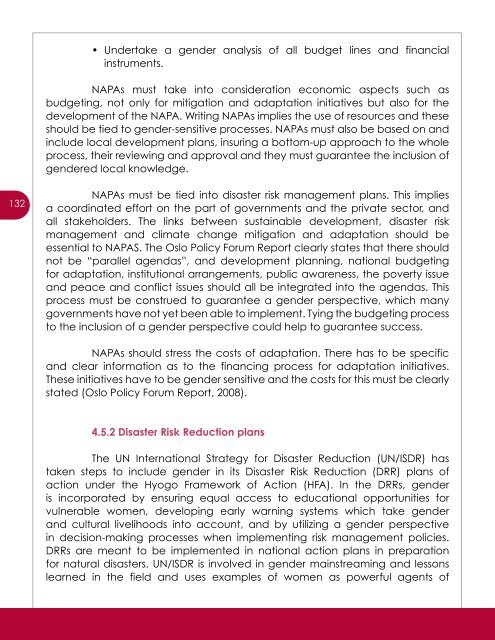GGCA Gender and Climate Change Training Manual - Women's ...
GGCA Gender and Climate Change Training Manual - Women's ...
GGCA Gender and Climate Change Training Manual - Women's ...
Create successful ePaper yourself
Turn your PDF publications into a flip-book with our unique Google optimized e-Paper software.
• Undertake a gender analysis of all budget lines <strong>and</strong> financial<br />
instruments.<br />
NAPAs must take into consideration economic aspects such as<br />
budgeting, not only for mitigation <strong>and</strong> adaptation initiatives but also for the<br />
development of the NAPA. Writing NAPAs implies the use of resources <strong>and</strong> these<br />
should be tied to gender-sensitive processes. NAPAs must also be based on <strong>and</strong><br />
include local development plans, insuring a bottom-up approach to the whole<br />
process, their reviewing <strong>and</strong> approval <strong>and</strong> they must guarantee the inclusion of<br />
gendered local knowledge.<br />
132<br />
NAPAs must be tied into disaster risk management plans. This implies<br />
a coordinated effort on the part of governments <strong>and</strong> the private sector, <strong>and</strong><br />
all stakeholders. The links between sustainable development, disaster risk<br />
management <strong>and</strong> climate change mitigation <strong>and</strong> adaptation should be<br />
essential to NAPAS. The Oslo Policy Forum Report clearly states that there should<br />
not be “parallel agendas”, <strong>and</strong> development planning, national budgeting<br />
for adaptation, institutional arrangements, public awareness, the poverty issue<br />
<strong>and</strong> peace <strong>and</strong> conflict issues should all be integrated into the agendas. This<br />
process must be construed to guarantee a gender perspective, which many<br />
governments have not yet been able to implement. Tying the budgeting process<br />
to the inclusion of a gender perspective could help to guarantee success.<br />
NAPAs should stress the costs of adaptation. There has to be specific<br />
<strong>and</strong> clear information as to the financing process for adaptation initiatives.<br />
These initiatives have to be gender sensitive <strong>and</strong> the costs for this must be clearly<br />
stated (Oslo Policy Forum Report, 2008).<br />
4.5.2 Disaster Risk Reduction plans<br />
The UN International Strategy for Disaster Reduction (UN/ISDR) has<br />
taken steps to include gender in its Disaster Risk Reduction (DRR) plans of<br />
action under the Hyogo Framework of Action (HFA). In the DRRs, gender<br />
is incorporated by ensuring equal access to educational opportunities for<br />
vulnerable women, developing early warning systems which take gender<br />
<strong>and</strong> cultural livelihoods into account, <strong>and</strong> by utilizing a gender perspective<br />
in decision-making processes when implementing risk management policies.<br />
DRRs are meant to be implemented in national action plans in preparation<br />
for natural disasters. UN/ISDR is involved in gender mainstreaming <strong>and</strong> lessons<br />
learned in the field <strong>and</strong> uses examples of women as powerful agents of

















